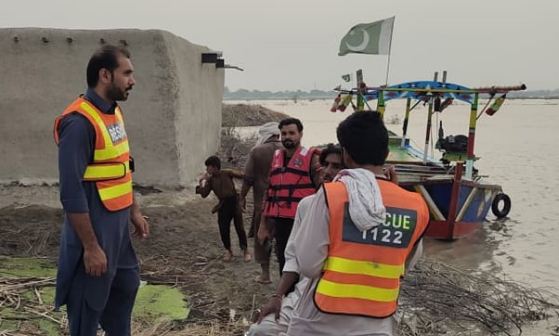ISLAMABAD, AUG 18: Pakistan is reeling under one of the deadliest monsoon seasons in recent memory, with relentless rains and surging floodwaters inundating vast swathes of the country.
At least 657 people have died and more than 920 injured since June 26 across the country, according to the National Disaster Management Authority (NDMA), as cloudbursts, flash floods, house collapses and lightning strikes continue to batter communities.
Khyber Pakhtunkhwa (KP) remains the worst-hit province, where remote mountainous districts such as Buner have become the epicentre of tragedy.
Meanwhile, the search is still on for many of those missing as Rescue 1122 officials a day earlier said they had recovered 373 bodies from the flood-hit areas across KP with majority of them from Buner district.
“The Rescue 1122 has recovered 373 bodies from all the flood-hit districts of the province till Sunday while rescue and search operation was still underway,” spokesperson for Rescue 1122 Bilal Ahmad Faizi told The News.
Meanwhile, fresh rains gripped parts of the country on Monday, compounding the misery of millions. In Mardan, heavy showers drenched the city and its outskirts, while Nowshera recorded thunderous rainfall across different localities. Swabi saw rainwater swamp low-lying areas, entering homes and shops. In Swat’s Mingora, torrential downpours paralysed daily life, while nearby Malakand also recorded significant rainfall.
In Buner, relief operations faced major hurdles, with volunteers struggling to reach affected villages as a makeshift bridge connecting a cut-off settlement risked collapse. Parachinar witnessed flash floods that swelled streams and the Kurram River, damaging roads and embankments. Officials confirmed no casualties but said restoration work was underway.
In Nowshera’s Chakki Mamrez area, tragedy struck when a room roof caved in during the downpour, killing a husband and wife.
The provincial capital Peshawar faced severe urban flooding after intermittent rain since Sunday night. Overflowing drains inundated Saddar Bazaar, University Road, Bara Road, Gulbahar, Kotla Mohsin Khan, Phando, Zaryab Colony, Gulberg, Fakirabad, Pajjagi Road, Hayatabad and Shaheedabad. Streets turned into rivers, paralysing traffic and submerging vehicles, while water also entered the Western Police Station and numerous houses.
In Punjab, persistent downpours lashed Multan, Kabirwala, Jhang and Khushab, bringing both relief from heat and flooding in low-lying areas. In Chakwal, heavy rainfall was measured at Wahali Zair (25mm), Choa Saidan Shah (67mm), Lillandi (11mm) and Kusk (35mm). Bhakkar and Miani reported inundated neighbourhoods after continuous rainfall.
Quetta and parts of Balochistan remained cloudy and humid, with the Met Office predicting rain in Zhob, Musakhail, Mastung, Loralai, Kohlu, Kalat, Barkhan and Sibi, and scattered showers in Dera Bugti, Nasirabad, Khuzdar, Awaran, Ormara, Pasni and Lasbela. In Azad Kashmir, thunderstorms lashed Dhirkot and various parts of Poonch division.
Rivers and dams under pressure
As rain-swollen rivers surged, authorities issued flood warnings along the Indus. Medium flood levels were recorded at Kalabagh, Jinnah Barrage and Chashma Barrage in Mianwali, where inflows continued to rise. At Jinnah Barrage, water inflow stood at 439,586 cusecs with outflow of 422,586 cusecs, while Chashma reported 483,512 cusecs inflow and 466,312 cusecs outflow. Evacuation instructions were issued for vulnerable riverbank settlements.
In Kot Addu, the Indus at Taunsa Barrage reached medium flood levels with inflows of 454,356 cusecs and outflows of 453,856 cusecs, the Irrigation Department confirmed. The Flood Forecasting Division said the Indus remains in medium flood at Tarbela, Kalabagh, Chashma and Taunsa, while Guddu Barrage is in low flood. The Sutlej River is also in low flood at Head Sulemanki and Ganda Singh Wala.
Reservoirs are filling fast — Tarbela Dam is 97% full at 1,546.60 feet, while Mangla Dam is at 71% capacity at 1,213 feet. Flows in the Kabul River at Nowshera, and the Jhelum and Chenab rivers remain normal. Minor low floods persist in Nullah Aik, Nullah Dek, and tributaries of Ravi, while the Nari River in Sibi and hill torrents in Dera Ghazi Khan and Rajanpur are flowing normally.
The Pakistan Meteorological Department (PMD) has forecast that heavy rain and thunderstorms will persist until August 19, with at least three more wet spells expected, the next one likely after August 22. Areas most at risk include Charsadda, Nowshera, Mardan, Swabi, Khyber, Orakzai, Kurram, Hangu, Karak, Bannu, Lakki Marwat, Tank and DI Khan.
Nationwide toll continues to rise
The NDMA confirmed that of the 657 deaths nationwide, 171 were children, 94 women and 392 men. KP alone accounted for 390 deaths, including 288 men, 59 children and 43 women, underscoring the province’s disproportionate vulnerability.
In Punjab, 164 people have died in rain-related incidents, the majority children (70), followed by 63 men and 31 women. Sindh reported 28 fatalities, including 14 children. In Balochistan, 20 people have died, most of them children. Gilgit-Baltistan has seen 32 deaths, while Azad Kashmir reported 15 and Islamabad Capital Territory (ICT) eight.
The NDMA said it is working closely with provincial authorities to accelerate relief and rescue efforts in the worst-affected areas.
Authority’s chairman Lieutenant General Inam Haider warned the public of heightened risks: “The intensity of this year’s monsoon is around 50% to 60% more than last year. Two to three more monsoon spells are expected until the first weeks of September,” he said in Islamabad.
Landslides and flash floods are a recurring feature of Pakistan’s monsoon season, which typically begins in June and tapers off by late September. The rains bring South Asia about three-quarters of its annual water supply, crucial for agriculture and food security, but they also leave a trail of destruction.
According to Pakistan’s chief meteorologist, Zaheer Babar, the country is witnessing a rise in the frequency and intensity of extreme weather events. He explained that heavy downpours in the mountains often turn into flash floods downstream, catching residents in low-lying areas off guard.
Babar noted that climate change is a key factor driving this volatility, but human practices worsen the impact. Homes built along riverbanks, constricted waterways, and garbage dumping restrict the natural flow of rainwater, amplifying the devastation.
Pakistan remains among the world’s most climate-vulnerable countries, repeatedly battered by extreme weather. In 2022, monsoon floods submerged a third of the country and claimed around 1,700 lives, underscoring the scale of the challenge.
— With additional input from Reuters, AFP and APP

















